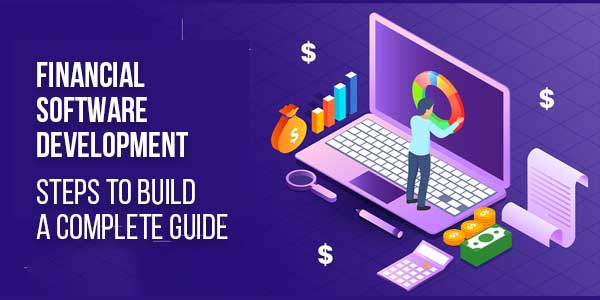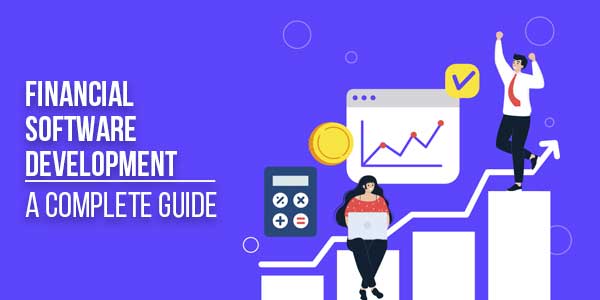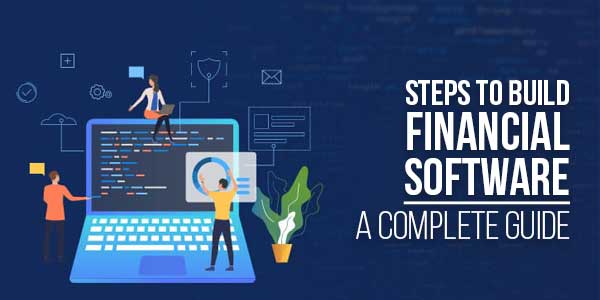
Fintech is everywhere. From an EMI calculator for your car loan to scanning a QR code in a grocery store, everything is Fintech. If we have to define this term simply, we could say that it’s an approach that combines finance and technology. But implementations are indeed far deeper and quite more complicated. Fintech or finance software development means building a system that can provide timely, customer-oriented, convenient, and secure financial services just like making money transactions.
With a digital-first solution, Fintech can solve many traditional finance-related problems as it comes with some powerful components. Digital offerings in the finance sector are not appealing just to customers, its benefits attract more people to enter this business space. This leads to cut-throat competition which reduces your chances of dominating the market.
But if you do the financial software development right then you might just succeed. And the fact that you are here reading this guide says that you are doing everything you can to save the top spot for you.
This is a carefully curated guide that can get you up to speed with financial software development services and everything else you need to know to enter and win in this business space.
Table of Contents
Growing Fintech Market:
It is expected that by 2026, the global finance market might just reach a gigantic valuation of approximately $234 billion. And it is needless to say that in this digital era, the major chunk of that market is completely driven by the digitization of financial services. May it be digital applications or mobile banking solutions, more and more users are moving towards fintech whether they realize it or not to perform the same tasks they used to do after waiting in long queues at banks.
Geographically speaking, the reach of Fintech is substantially higher in areas such as the Middle East, Africa, Europe, Asia Pacific, and North and South America. And it might pique your interest to know that among these locations, Asia Pacific has registered the highest growth in the fintech sector.
Along with the factors like openness to new technologies, a high population of millennials, expanding customer base and Genz, the locality of these locations is extremely favorable to the Fintech startups which resulted in a rise in the number of fintech companies.
Must-Have Features For Financial Software Systems:
What are we discussing here is a list of basic features that will be part of every fintech application. But it is important to note the features that will be a part of your fintech application completely depend on what kind of app you want to develop, what are your project requirements and what kind of model of fintech you choose.
1.) Secure Authentication:
Authorization is the most important aspect of any application let alone fintech. It can be said to be the first line of defense that protects your app. Multiple-factor authentications are used nowadays that include email, biometric, phone number verification, OTP-based registration, and more. In other words, this is the stage where you can tell your users how secure their activities are on the application and how tightly knit their data is protected from external threats.
2.) Model-Specific Functions:
Model-specific functions are the core of your financial services offerings. Let’s say if you are developing a personal finance management application then you have to offer features like a dashboard with expense and income summaries, multiple account links, and more. AI-based highlights like tabs on regular payments, what expenses you can avoid, and more.
3.) Payments:
In every fintech application, payment will remain a common feature. But what would people need, may it be a B2B vendor management software or a personal finance management app, to make real-time, and secure payments to others? To facilitate that, you add suitable functionalities such as QR codes, bank-to-bank transfers, in-app wallets, and more depending on the model.
4.) Dashboard:
Every software and application needs a good tracking management system no matter what industry it is. May it be fitness or fintech, a dashboard can always come in handy. It brings all the data together like your income and your expenses, upcoming payments, investments, market updates, and more so that all the complex data is easily digestible and you get a complete overview of your financial situation.
Mostly, dashboard features allow you to generate and download reports that allow the users to get a detailed view of their finances.
5.) Notification:
Customers would only use the app when they feel the need to. But to ensure that they keep coming back and build good customer relationships, businesses can connect with the users through notifications. They can be used effectively to remind the app users about their debits and credits, new offers, change in investment rates, loan application status, and more. Although, it is more important to plan out your strategy to send notifications in such a way that it doesn’t seem untimely or intrusive.
6.) Integrations:
Third-party integrations are used to offer extra features and functionalities and easy access to the users. This may be related to the bank’s security software, payment, and notification system. When integrated with the right APIs, the app would allow the users to checkout and find the nearest bank or ATM location, track their money across multiple accounts, and so on.

The Stages Of Fintech App Development:
Although every finance software is unique, the process behind their development is almost identical.
Requirement Gathering:
In this stage, the stakeholders and project managers sit with the developers to understand what are the objectives of this project and what would you require to successfully achieve it.
It is a part of software development consulting where brainstorming sessions are held to discuss the tools and technologies to use to build various features and functionalities for this product. Once every bit of information is collected, you have to move on to creating a project scope where you have to build a timeline and milestones for the project.
Software Design:
The first impression is the last. So yes your fintech software application must have an elegant design that keeps bringing customers back. Additionally, your application shouldn’t be hard for the users to navigate to do their financial activities. Make it easy for them to do whatever financial services you are enabling them with and that too in minimal time. These things are important and that’s why you have to be careful with UI/UX development.
MVP Development:
Once your app design is ready, you are good to go to code the features and functionalities of the product. Just start with the basic functionalities of your app and test its security too. You can just add the basic MVP features to the app and then offer it to the beta users to gather feedback. They can help you understand what’s working in your application, what you need to change, and what more you need to add.
Once you have enough data, you can move on to build the real deal. Add advanced features and functionalities along with the changes suggested by your users and make it ready for testing and development.
App Testing:
Before launching your application, you have to make sure that every feature and functionality that you have added to the application is working exactly as it is supposed to or expected to. Although nowadays the test-driven development approach is still adopted, in the testing phase you have to thoroughly test the software system to detect bugs and errors. You should also start preparing test cases right from the requirements-gathering phase about real-world scenarios to test whether your code would work or crash under it.
App Launch:
After the product is developed and tested, we have to take this application on a platform for the launch. The platforms can be user-specific, it can be just one or even multiple platforms where you want to launch your application, depending upon your project requirements and budget.
App Maintenance:
The last stage of fintech development will be app maintenance. Because your work doesn’t end when you launch the product. You have to constantly work on the product post-deployment to ensure that your app is secure from external threats and can stay updated on the latest features and functionalities. You should also keep track of the reviews left by the users and help them solve their queries.
Financial Software Development Cost:
The estimated development cost of a fintech application can be around $30,000 to $500,000. But you can’t get a definite price until you have sorted out all your requirements. Also, the cost would be determined by various factors such as the location of the development company, the type of team, the type of application, and more.
Here in this section, we will have a look at all of these factors and their estimated cost of finance software development. Typical prices for the type of applications are as mentioned below:
| Type of Application | Cost of the Application |
| Banking app | $165,000 – $180,000 |
| Investment app | $55,000 – $65,000 |
| Consumer Finance | $70,000 – $90,000 |
| Insurance app | $100,000 – $120,000 |
| Lending app | $80,000 – $100,000 |
The next most important factor affecting the development cost is who is working on your project, are they in-house developers, freelancers, or a dedicated team hired from a software vendor?
The type of developers you pick for your project also determines the development costs. Assuming a team has to take 1000 hours to develop a fintech app then their estimated price would be as shown in the table below:
| Team Type | Development Cost |
| In-house | $80,000 |
| Freelancers | $30,000 |
| Multi-skilled agency | $50,000 |
Another factor to consider in the development of a fintech app is the location of an agency if you hire a technology partner to help you develop the product. The development prices vary based on the geographical locations as you move from the USA to India.
For example, a developer in the USA would charge you around $100 to $120 per hour for your fintech software development project. Meanwhile, you can hire an Indian developer for around $60-$80 per hour with the same quality and delivery promises.
Fintech Software Regulations:
Forget success, if you want to launch and keep your app in the fintech market then you have got to comply with all the regulations of the industry. Following the guidelines to launch the app will help you build trust among users as well as it can save you from hefty fines. After all, if you are working in an industry, you have to follow its rules if you want to succeed.
1.) GDPR:
GDPR is one of the common data protection regulations in the EU. It dictates how a business should gather, process and store the data of their EU users. If you fail to comply with the GDPR rules then you might be fined as high as €20 million depending upon the violations. More regulations like California Consumer Privacy Act (CCPA) and Consumer Data Rights (CDR) are in line with GDPR and every fintech company has to follow them.
2.) KYC:
KYC is essential for every financial organization. It is done to Know Your Customer as well as verify their identity. May it be banks or any other financial services provider, every business needs to adhere to it. Frauds are the most common occurring in the finance sector, to minimize these threats and other risks, it is essential to follow KYC for both fintech companies as well as customers.
3.) FTC:
There are many regulations that you have to follow in the US alone. But you are likely to come across the Federal Trade Commission more often. These regulations include Gramm-Leach-Bliley Act (GLBA) and the Fair Credit Reporting Act (FCRA).
The GLBA regulates the fintech development companies about customer data protection and ensures that they stay transparent on their data processing. Meanwhile, the FCRA covers consumer credit information. If you are dealing in financial lending or processing the credit scores of the users then you have to comply with FCRA.
4.) PCI DSS Compliance:
PCI-DSS is a regulation that governs credit card payments. It exists to make sure that all the transactions are processed securely. There are six aspects of businesses that you need to prepare for compliance with PCI-DSS standards. If you fail to comply then you will be charged with a fine of around $5,000 to $100,000 per month.
5._ EFTA:
The Consumer Financial Protection Bureau governs the Electronic Fund Transfer Act which oversees electronic money transfers such as through debit cards, POS terminals, ATMs, and more. These regulations are created to protect the users when errors occur during electronic transactions like transferring money to the wrong account.
Fintech Software Development Challenges:
The toughest task in establishing a business is to predict various types of challenges you might face and be ready for them. If you want to make a future-ready fintech app then it is recommended that you look into these challenges and prepare your business to overcome them.
Finding A Gap:
The best product idea a business can select is the one that solves a problem masses are facing. So it is highly recommended that b experts opt for the sub-sector that can bring in more revenue. According to that, the two most lucrative fintech fields are personal finance and digital payments. Once you have decided on your niche, you have to move on to do market research to find out the blind spots to explore.
Planning Out The App Features:
It is relatively easy to know what problem needs solving but is a whole lot tougher to know how it can be solved. Maybe that’s why it is not solved yet. Business owners must have a vision of what their fintech application should like and work like. They must also be aware of its MVP features to test in the market and decide where they would need the help of the experts.
You can list every possible market problem that needs solving or that you think your app can solve and then against it, list down what MVP features you need to add or use in your app to solve those problems.
App Security:
The security of your fintech app can be compromised in various ways, the more layers of protections you add to it, the better. But it is also important to know that hackers too are armed with advanced technologies that can bring down your app and your business so you can never let your guard down. And when you are working in a sector that deals with people’s money, you can never be too careful.
Also, you will have the sensitive financial data of the app users protecting those datasets is also a top priority for your business. Losing them would be equivalent to losing people’s trust and eventually your business.
Therefore, you need to follow the best security practices during designing, development, deployment as well as maintenance of the application.
Following Compliances:
As we already saw before, there are just so many regulations to follow in every industry, every country has its regulations, and find out the ones that you need to address and follow is a challenging task. Every aspect of your application like your features and functionalities must also meet the regulations guidelines. There is no room for any flexibility, you have to follow them all to the T.
Leveraging Next-Gen Technologies:
The prospect of using the latest technologies like AI, IoT, and more might be very exciting but their implementation is equally challenging. It isn’t like you can call yourself an AI-powered fintech company just because you are using AI chatbot for customer support. You must integrate these technologies with your development frameworks to create a better customer solution. And that would demand some great experience and expertise.
Hiring A Finance Software Development Company:
The success of your financial software development project depends on what kind of development partner you choose to work with. Their experience and expertise will affect the quality and market performance of your application. There are some factors that you should look into before picking a finance software development company.
1.) Expertise:
The first and foremost thing you should check in any software vendor is their expertise and their capabilities to deal with complex projects. After all, they will be doing all the development work for you.
Additionally, you must also verify that their working culture, business model, or at least their development approach match yours. They must also be aware of the potential pitfalls in fintech development and how to avoid them.
To verify all this information, you can check out their previous works, case studies, and client testimonials.
2.) Understanding Of Compliances:
In a data-heavy industry such as finance, fintech business owners and software developers must know all the regulations they need to comply with as per their sector and the geographical locations of their market. Knowing how to build features isn’t enough anymore, they must also learn how to design them specifically to fulfill the requirements of regulations. So check whether they are completely aware of all the regulations or not.
3.) Price Quote And Delivery Timeline:
The most critical factor that influences the decision of picking a finance software development company is the price these vendors quote as it directly affects your project budget. It might be appealing to choose the company that quotes the lowest prices and fastest delivery time, it is wise to verify that their offerings are of top quality otherwise such promises aren’t worth it.
Conclusion:
In this article, we discussed the growth of the fintech market, reasons why you should invest in a fintech app, most features of the app, regulations to follow, a summary of various stages to finance software development, challenges along the way, and how you can hire a finance software development company to guide you through all of it. If you have any more questions or queries, please feel free to ask them in the comments sections below.

 About the Author:
About the Author:
















Be the first to write a comment.